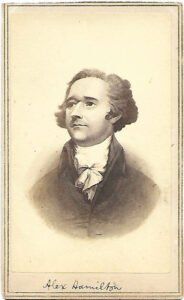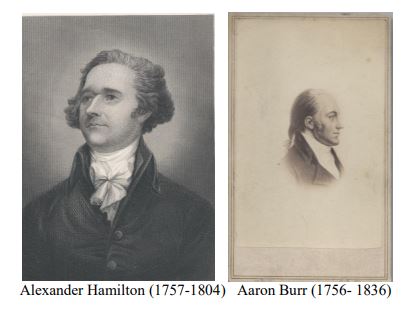July 11, 1804: Vice-President Aaron Burr Kills Treasury Secretary Alexander Hamilton In A Duel.
You are there: In the most notorious duel in American history, the sitting Vice-President, Aaron Burr, kills Treasury Secretary, Alexander Hamilton.
The bad blood between the two is long-standing.
Both men serve nobly under Washington in the Revolutionary War, but the General always seems to favor Hamilton, a source of some early animosity. Burr fails to get the field promotion he feels he deserves for saving the army on Manhattan. He also fails to get Washington’s support for a ministerial post to France; and it becomes clear that the General regards him as overly ambitious and prone to intrigues. Burr senses Hamilton’s hand at work in these reversals.


The two are also on opposite sides in the political arena – Hamilton as staunch Federalist and Burr as a loyal Democratic-Republican. As they climb the power ladder in the capital, they are forever at odds and willing to undercut the other.
In 1795, Burr and fellow Democratic-Republican, James Monroe, conspire to pull Hamilton down from his Secretary of the Treasury post, by leaking the story of his year-long affair with the abused and abandoned Maria Reynolds. This forces Hamilton to make an embarrassing public confession, and to resign from office.
Henceforth Hamilton will search for any opportunity to destroy Burr.
His first chance materializes in the presidential election of 1800, where Burr and Jefferson end up tied with 73 Electoral Votes apiece and the final decision falls to the Federalist controlled House of Representatives. Hamilton, of course, is unhappy with both options. But, on a 36th ballot, he uses his influence to elect Jefferson, who he claims is “less dangerous than Burr…who loves nothing but himself.”
This scenario is repeated in 1804 when Burr runs for Governor of New York and The Albany Register publishes a supposed quote from Hamilton calling Burr “a dangerous man…who ought not be trusted with the reins of government.” After losing by a decisive 58%-42% margin, Burr’s hopes for high political office are over and he places much of the blame on Hamilton.
After the election, a series of increasingly tense exchanges occur between the two men in written notes, which lead on to a “challenge” from Burr, which Hamilton accepts. Both men have been “called out” before on numerous occasions, all so far “resolved” without any shots being fired. But this time, the long-term hostility runs deep, and the duel unfolds.
It is set for July 11, 1804, at the Heights of Weehauken in New Jersey – a popular site for dueling, despite the fact that it is officially outlawed both there and in New York. The ground holds special meaning for Hamilton. On November 23, 1801, his 19 year old son, Philip, is shot dead here in a duel he has initiated in defense of his father’s name.
Be it premonition or not, the elder Hamilton writes out a will on July 10, the day before the duel. He states that he intends to “withhold his first fire,” and then addresses his wife:
Adieu best of wives and best of Women. Embrace all my darling Children for me. Ever yours, AH.
Around 7AM, Burr and Hamilton arrive by separate boats, rowed from mid-town Manhattan some three miles across the Hudson. Both men greet each other formally, Colonel Burr and General Hamilton, according to the code.
An area extending some ten paces is cleared, with Hamilton standing on one end, facing the Hudson, and Burr at the other, looking inland. Each man holds a .56 caliber pistol, provided by Hamilton, the same pair his deceased son used. The pistols are loaded by seconds in plain sight. The two combatants assume the classical positions –right foot forward, with bodies tucked sideways to present the smallest possible silhouette for targeting. Hamilton dons his glasses at the last second. The rules are then read aloud, as follows:
The parties being placed at their stations, the second who gives the word shall ask them whether they are ready; being answered in the affirmative, he shall say- present! After this the parties shall present and fire when they please. If one fires before the other, the opposite second shall say one, two, three, fire, and he shall then fire or lose his turn.
Hamilton’s second is chosen by lot to say the word present, which he does. Exactly what happens next is the subject of some debate. All accounts agree that both men fired, but who shot first is open to question. Some argue that Hamilton fired into the air, throwing away his attempt. A subsequent search for the ball finds it in a tree limb, some seven feet above and four feet wide of Burr’s position.
But Burr’s ball catches Hamilton above the right hip, fracturing a rib, slicing through his liver, and ending up lodged in lower vertebrae. Burr advances toward his fallen foe, but is quickly diverted by his seconds and leaves the scene.
Hamilton is in the arms of his second, Nathaniel Pendleton, when his medical man, Dr. Hosock, examines the wound and recognizes that it is mortal. Together the two men carry Hamilton, who remains conscious, to his boat, and row him back to Manhattan. He is put to bed and given heavy dose of laudanum for pain. He lives through the night and dies around 2PM the next day.
The nation is shocked by Hamilton’s death, and cries mount to put an end to dueling. Burr is indicted for murder and flees to South Carolina. But the case for retribution against duelists is not intense, and he amazingly returns to the capital to serve out the remainder of his term as Vice President.
Burr will live in and out of the public spotlight for another 34 years after the events at Weehauken, including a four year escape to Europe after being acquitted in a sensational 1807 trial for treason brought by Jefferson.
